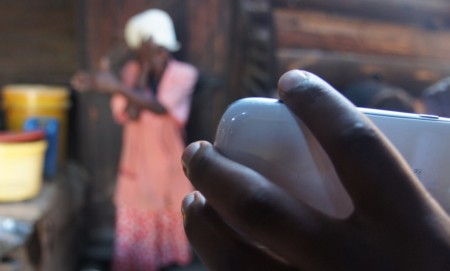
Smartphones have the potential to greatly increase access to eye health care in remote and rural areas where specialist resources are scarce.
Credit: Peek Vision
New research shows that a smartphone decision-guiding app can help community volunteers to identify and refer patients to eye care services almost as effectively as an experienced eye health professional.
The peer-reviewed findings suggest that similar apps could in future help to free up scarce specialist eye health resources, improving the reach and effectiveness of eye health programmes and making them better value for money.
Specialist eye health resources are extremely scarce in many low- and middle-income countries, but there is a huge unmet need for eye health services – one in eight people worldwide need better access to eye health. Moreover, eye health specialists tend to be concentrated in urban areas, meaning eye health is even harder to access for rural populations.
A team of researchers from the International Centre for Eye Health (ICEH) at London School of Hygiene & Tropical Medicine (LSHTM), Kitale County and Referral Hospital in Kenya and Peek Vision developed an app which guided non-specialist community volunteers through a series of questions to help them make a referral decision.
By using an iterative design process, the team were able to fine-tune the app to determine which questions most often led to accurate referral decisions. The app included questions about a person’s age, eye symptoms and signs, plus distance and near vision tests, as criteria for the decision on whether to refer them for further examination.
The team tested the app in an eye health screening programme in a rural region of Trans Nzoia county, Kenya. Once the app had been fine-tuned, the community volunteers’ decisions agreed with those of an experienced ophthalmic clinical officer (an eye health specialist) at least 80% of the time.
In the final iteration, community volunteers’ positive decisions (to refer an individual for further examination or treatment) agreed with the experienced ophthalmic clinical officer in almost 9 out of 10 cases. Community volunteers’ negative decisions (that a patient did not need to be referred for further treatment) agreed with the experienced ophthalmic clinical officer in over 8 out of 10 cases.
According to the study’s lead author Dr Hillary Rono, a researcher at ICEH, Peek’s lead in Kenya and an Ophthalmologist at Kitale Eye Hospital, “Our findings suggest that clinical decision guidance apps like the one we developed could provide a way to effectively increase the capacity of eye health services by allowing community volunteers or other non-specialists to accurately refer people for further treatment.”
“As an eye doctor working in a largely rural region of Kenya, there are many challenges to reaching our patients. I am continually looking for ways to maximise the specialist eye health resources we have. While more research and testing will be needed to see whether these findings can be extended to different locations and at a larger scale, it is clear that this type of technology has great potential to improve eye health programmes in low-resource settings.”
A further advantage of the app is that it can provide clear data on referrals and their outcomes, allowing programmes working with non-specialists to be closely monitored and adjusted if needed. The research is now being used to inform further developments of Peek’s technology-based solutions to help eye health services in low- and middle-income countries improve.
“These are really promising findings,” said Dr Andrew Bastawrous, Peek CEO and also a researcher at ICEH. “While this decision-making technology is not yet widely available as part of Peek’s eye health technology solutions, this is the first step towards realising the great potential in this area. The next step for us is to see how we can incorporate this kind of technology into our existing apps and programme support tools, so we can give our partners even more power to improve the efficiency and equity of their services.”